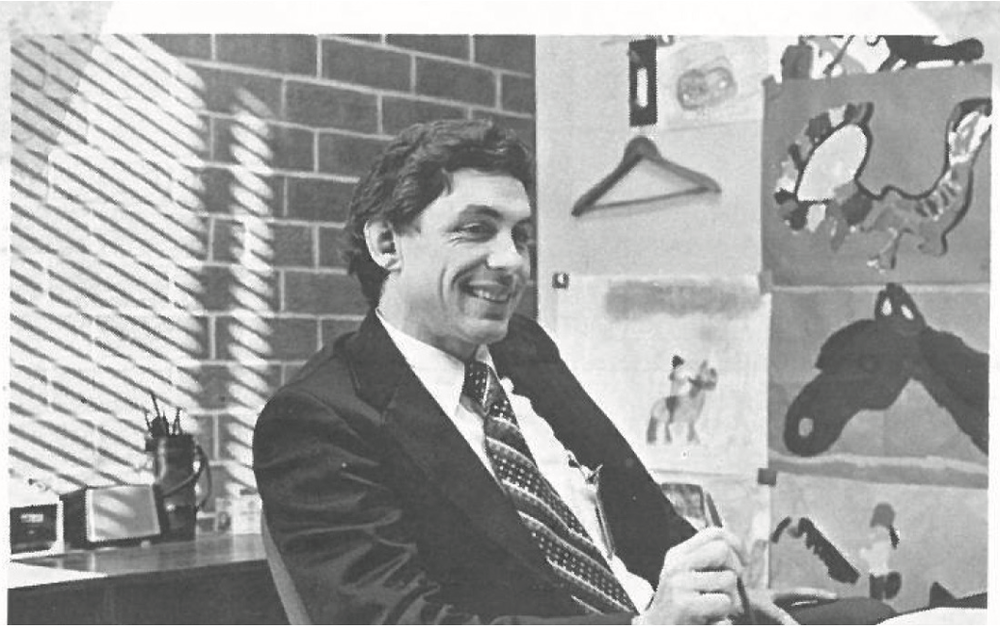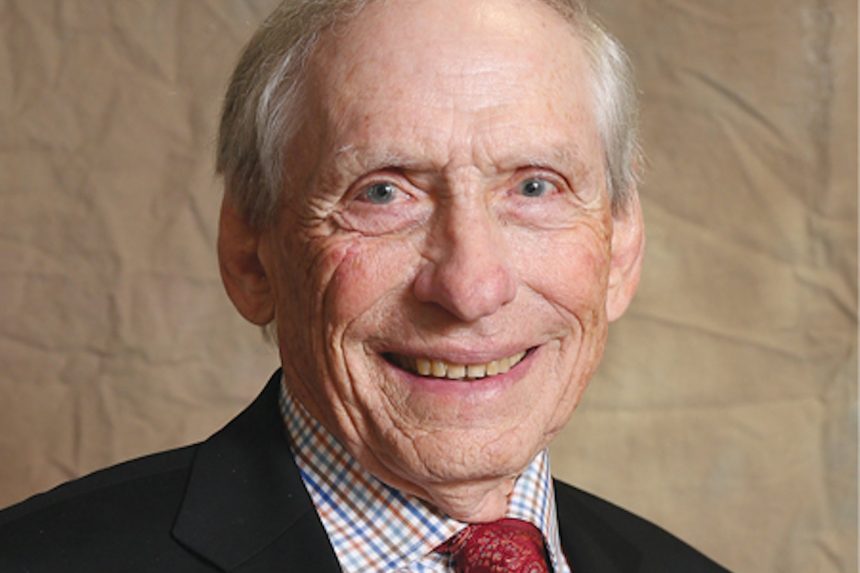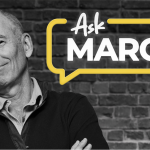Today, most people take their checkout experience at the supermarket for granted. They push up their carts, unload their groceries and watch as the cashier scans item after item. It just makes sense, so much that older generations hardly remember the days when products were stamped with prices to be rung up manually, and younger ones rarely consider a world where that was the norm.
That’s because the Universal Product Code (UPC) — the barcode used on every product in grocery and retail stores all over the globe — changed everything 50 years ago. Barcodes are scanned billions of times each day, and award-winning engineer Paul McEnroe, who spent more than two decades in leadership roles at IBM, assembled and led the team that transformed the technology from an idea into the reality that endures.
But McEnroe’s role in developing the barcode hasn’t been fully acknowledged. The UPC’s unpatented technology is in the public domain, so McEnroe earns no royalties from the invention, and a quick Google search for “who invented the barcode” turns up a Wikipedia page lauding someone named Norman Joseph Woodland.
So, what happened?
It’s a big question that McEnroe is eager to answer in his memoir The Barcode: How a Team Created One of the World’s Most Ubiquitous Technologies, forthcoming from Silicon Valley Press on September 19.
Image credit: Courtesy of Smith Publicity
Related: How Entrepreneurial Creativity Leads to Innovation | Entrepreneur
Entrepreneur sat down with McEnroe ahead of the memoir’s publication to learn more about how the UPC came to be, where the confusion over its inventor stems from and what advice he’d give young leaders who want to change the world like he and his team did so many years ago.
“We could come up with some kind of a symbol to be read optically or magnetically.”
It all started in 1969. IBM wanted to explore growth opportunities and buy startups, but the company was told it wouldn’t succeed. “Everybody important, all the inventors and so on, are going to quit the next morning because they don’t want the white shirts, blue coats, red ties and black wingtip shoes that was the culture of [IBM at] the time,” McEnroe says.
Determined to innovate despite that reputation, IBM “decided to paint an imaginary red line” around part of the company and charge McEnroe with leading it — so he did. The Dayton, Ohio native grew up “in the shadow of the National Cash Register Company,” which had a monopoly on checkstands worldwide, and he knew there was a better way to do the “big, old, cast-iron cash register’s job.”
People in the supermarket and retail sectors agreed. There was a common refrain: We need to do a better job of inventory control. We’re spending a tremendous amount of money. Marking the price on every item in the store takes a lot of time, and as soon as we mark the prices, they’re wrong.
McEnroe was well aware of technologies that could address the problem. “We could come up with some kind of a symbol to be read optically or magnetically,” McEnroe says. He and his team would do both — though the optical one “has taken off the most.”
The recently invented laser provided a directional and consistently distributed light source, and McEnroe was familiar with the technology, having used it in previous projects. The low-cost, low-power, safe option offered an opportunity to make progress on the UPC.
Related: IBM Says 7,800 of Its Roles Could Be Replaced By AI | Entrepreneur
“So, I went to [IBM], just like you would go to a venture capitalist today in Silicon Valley or Boston or wherever, and I proposed that we go after this business,” McEnroe recalls, “that we build equipment that would fit in the stores, inventory equipment that would sit in a warehouse and control equipment that would sit at the headquarters. And it would all work together.”
The technology would use item identification for automatic reordering and listing on the display and cash register slip, featuring the name of the product purchased, how much it cost and any other necessary information.
McEnroe requested three years of funding from IBM: $300,000 for the first year, $1,000,000 for the second, and $3,000,000 for the third. The company agreed and asked McEnroe to do the job in North Carolina, where it had just built a plant that wasn’t yet filled with production equipment. So McEnroe made the move and hired six people for his team.
“I think it’s been very good for society because nobody has had to pay anything for the use of the code.”
The following year, in 1970, the National Association of Food Chains (NAFC) formed a committee to examine the problem of item identification, hiring consulting company McKinsey to help it do so. By 1971, McEnroe and his team had developed their code, and in 1972, the supermarket committee asked all interested companies to present proposals for how they would automate supermarkets, including item identification.
Those who submitted codes had to agree to donate them to the public domain before they could be accepted, which meant no patents or royalties for their inventors. As a result, McEnroe and his team didn’t expect to see any money from the UPC. “That’s the way it’s worked out,” McEnroe says. “I think it’s been very good for society because nobody has had to pay anything for the use of the code.”
McEnroe and another team member named Jack Jones share the patent on the pistol-grip handheld barcode scanner, though they don’t earn any royalties from it either. “As far as I know and at least during my time, when engineers signed on with IBM they signed all the rights to any patent they may do while working for the company to the company itself, so IBM owns the patent not the inventor,” McEnroe explains.
In 1973, the committee chose McEnroe’s team’s code and proposal, and they shipped the first products out in 1974, though only to five supermarkets. It took several years to “achieve a reasonable volume,” McEnroe recalls. At that point, he left the program to work in a different part of the company. By the early 1980s, the UPC had exploded.

Image credit: Courtesy of Smith Publicity
“[It] couldn’t have misreads and charge people the wrong price. That was the biggest single problem.”
Naturally, McEnroe and his team came up against some significant challenges during the UPC’s development and launch. They had to create a code that was “robust” enough to be read through plastic, which could be compromised by the way light shone, frost or any number of other factors. It had to work when it was pulled across the checkstand quickly and not necessarily held flat.
“You didn’t want the operator to even have to see the code,” McEnroe explains. “If she knows the codes are typically on the bottom of packages, pulls the package across, doesn’t even look at the bottom of the package. So it had to be very reliable. [It] couldn’t have misreads and charge people the wrong price. That was the biggest single problem.”
It took McEnroe and his team two years to build the self-correcting code that could fix itself automatically in real-time.
Other “extraneous technical problems” arose too — How to send the signal from the front of the store to the back efficiently? — but McEnroe says one of the biggest, unexpected problems was actually the technology’s public reception. “[There was] the social problem of people and organizations coming to grips with the fact that the price [was] no longer on the merchandise,” McEnroe explains.
“Labor unions were afraid that they were going to lose checkstand operator positions.”
The backlash was so extreme that the UPC’s public unveiling in 1974 didn’t go as planned. McEnroe’s chief engineer called him to say the store couldn’t open. McEnroe was shocked; they’d checked the technology so often, and it was so reliable. But it wasn’t a technical failure: It was a picket line.
“Labor unions were afraid that they were going to lose checkstand operator positions,” McEnroe says. “So they picketed the store, and then 18 states passed laws against taking the price off of the merchandise or laws that made it so if you had a scanner in the store, you couldn’t take the price off your merchandise.”
Related: Report: AI Will Take More Jobs Away from Women Than Men
McEnroe had to travel around the country to explain the technology’s benefits and safety, as operators might have to stand over the lasers for years. McEnroe knew the technology was safe; he’d brought monkeys from Africa and tested them at Stanford Research Institute.
“And of course it was safe because A, [the laser] didn’t come out the window, except rarely, and B, we had proved that if it did come out the window and they looked at it for several years, it still wouldn’t hurt them,” McEnroe says.
“I had known his name because I had studied the history of the codes. And his name was Joe Woodland.”
McEnroe built and led the team that developed the UPC, which became widely used by the 1980s and still is. But if you Google “who invented the barcode,” McEnroe’s name is scarcely seen. Instead, a Wikipedia page cites Norman Joseph Woodland and Bernard Silver as the technology’s co-creators.
Why? It started with the ring of a telephone.
After he and his team came up with their code, McEnroe got a call from another IBM employee based in New York. “I had known his name because I had studied the history of the codes,” McEnroe says. “And his name was Joe Woodland.”
On the call, Woodland reiterated that he’d invented a bullseye code for supermarkets in 1948. The code was patented in 1952, per the Smithsonian. By 1973, the Radio Corporation of America (RCA) owned the patent and was one of 14 companies that submitted a code to the committee for consideration, McEnroe recalls.
But there was one major issue with Woodland’s code, McEnroe says: It didn’t work well enough for supermarket and retail adoption.
According to McEnroe, Woodland knew it, too. “I’ve studied the code that your team has come up with, and I know my code, and your code is so much better that there’s no comparison,” McEnroe remembers Woodland telling him over the phone. “I would like to join your team. I would love to live in North Carolina and work for you and be your interface and your marketing person to market your code to the world.”
Gee, what could be better than having the guy who invented the first supermarket code — but one that didn’t work and had never been implemented — on your team? McEnroe thought.
McEnroe did hire Woodland, who moved down to Raleigh and spent the rest of his career working on the UPC project. McEnroe acknowledges that Woodland invented the first supermarket code but maintains that “Wikipedia just got it wrong.” “[Woodland’s code] was never used in any volume at all,” he explains. “Just in the test store that Kroger did in Cincinnati. I went and visited that store and saw it didn’t work either. And we tested it six ways from Sunday.”
Related: Can Robot Shoppers Tell If the Bananas Are Ripe? | Entrepreneur
“I don’t know what he told them. Whatever he told them, they actually gave him the Medal of Technology.”
So why do most inquiries into the barcode’s creator lead back to Woodland? McEnroe says George H.W. Bush’s presidential run against Bill Clinton played a significant role.
At the time, about 20 years after the UPC’s development, Bush was “not seen as coupled with the reality of the American housewife,” McEnroe says. Most people had been using the technology for more than a decade; to present a relatable front, Bush partook in a demo run by the Super Market Institute in Florida, “where a supermarket had been artificially set up inside of a convention center.”
Bush had a chance to use a scanner on the code for the first time. “So he got his picture taken, scanning items, and he said, ‘This is amazing. It’s the greatest technology I’ve ever seen — who invented this thing? And they said, ‘Well, we don’t know. Somebody from IBM,'” McEnroe says.
Bush told them to find out who it was because he wanted to give them the National Medal of Technology. When his people called the supermarket committee, they were given the original proposal put together by Woodland. “That’s the first thing I’d asked Woodland to do as a marketing guy — not an inventor of our code, but a marketing guy — to write the proposal for the barcode,” McEnroe explains.
Woodland wrote the proposal, and his contact information was on the back in case anyone had questions. The engineering group had already been disbanded; Woodland, nearing retirement, was the last one working on the barcode. “I don’t know what he told them,” McEnroe says. “Whatever he told them, they actually gave him the Medal of Technology.”
Related: Bill Gates Says These Tech Innovations Will Change the World
The Bush-Clinton race would further solidify the narrative of Woodland as the barcode inventor. As the tide turned against the incumbent, McEnroe recalls that the supermarket demo was written up in the news quite a bit, and he began to recognize a pattern in the telling of the technology’s development.
Typically, one paragraph would say Woodland invented the first supermarket code (“That’s quite true,” McEnroe admits). Another would describe Woodland’s role in marketing and selling the code McEnroe and his team created later.
“What he doesn’t say is that in between the two, his code wasn’t used for years and years,” McEnroe says. “And the other code was taken as the national standard. And it’s the one that everybody’s using. So the one that he promoted and the one that he was the marketing guy for was successful. And that is the universal product code; that’s the vertical bar code we have today. His original code didn’t go anywhere.”
Woodland’s patent had already expired by the time the supermarket committee convened. “The IBM lawyers said it didn’t even read,” McEnroe adds. “The whole method of deciphering how wide a black bar is in a white space is dramatically different. It’s a technical thing, but it’s dramatically different in our code [than] it was in [Woodland’s] circular code.”
Related: She Presented Her Life-Saving App to Tim Cook at Age 16
“This is a story that…gives you ideas about how you go about things to this day.”
McEnroe recognizes there’s “a lot of misunderstanding about who did what with the code” — and says ‘”it was time to get that corrected.” That’s why, 50 years after the UPC’s development, the engineer is publishing his memoir to help set the record straight. The book includes an appendix with documents that refute certain claims, like the misconception that IBM came up with the UPC in just a few weeks.
“There are a couple books that have been written by the Super Market Institute about incorporating [the UPC] into the supermarket itself and how it affected that,” McEnroe says. “But this is a story that shows not only that, but also how it was created — it gives you ideas about how you go about things to this day.”
McEnroe says he and his team thought the UPC might last 20 or 30 years, not as long as it has. But the UPC solved a problem that society was struggling with for some time, made checkouts work more efficiently, and was reliable and easy to implement — all things he believes contribute to a technology’s longevity. Even QR codes, which allow scanning in two directions for more data, are a variation of McEnroe’s code.
Related: How Menu QR Codes Became an Essential Tool for Every Restaurant and Bar
Not surprisingly, McEnroe is often asked for his advice to young professionals who want to change the world. And perhaps the most important thing, alongside a certain amount of luck and patience? Keeping an open mind, McEnroe says — but being “disciplined in your curiosity.”
“Fifty years ago, it was a lot harder to understand what was available in the world,” McEnroe explains. “And nowadays, with the internet, that’s a lot easier. Before, you had almost no choice but to be a degreed engineer, go to school, study at the school, go to the libraries. Now that would be fine, but you also can do a great deal of this work by using the internet and just searching things up. But you have to be careful about what you look up. Is it right, or just something somebody else wrote down?”
Being part of a team and recognizing that you can accomplish more together than you can on your own is also vital, as is maintaining those relationships along the way.
“Don’t burn your bridges as you go through life,” McEnroe says. “When you have to go back and call upon people, they’re going to be happy to come and help you again. I had to do that so many times, and everybody that I called upon to help me was extremely helpful. As you’re working with people when you’re younger, work with them well and leave a good taste in their mouth, and then they’ll help you later on.”
Read the full article here










